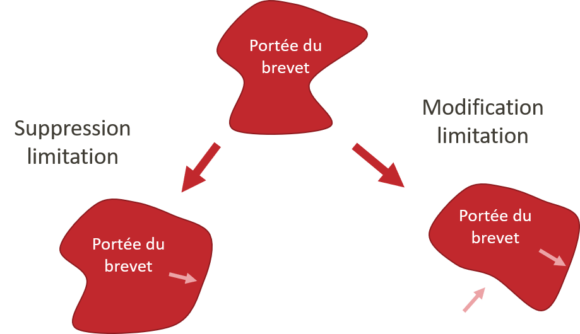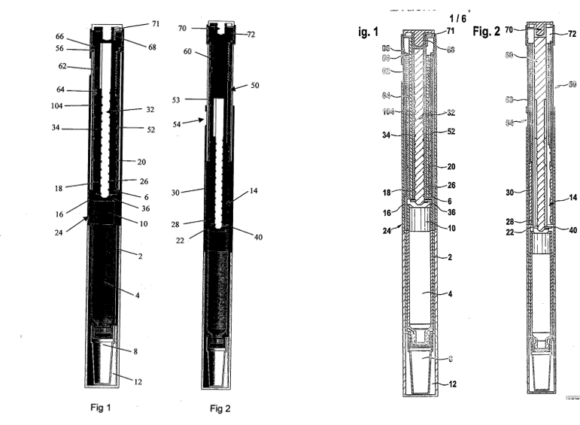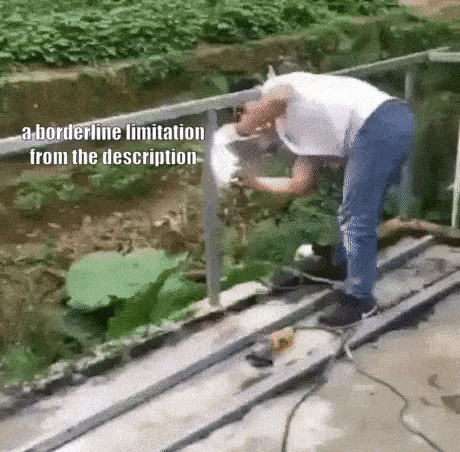
Principe
Ce principe mentionné à l’A123(3) CBE ne s’applique qu’après délivrance.
Une fois qu’un brevet est délivré, un acte d’un tiers ne constituant pas une contrefaçon ne peut pas devenir une contrefaçon du fait d’une modification apportée après délivrance (T1149/97 et Directives H-IV 3.1) quand bien même la description supporterait une telle modification.

Base de l’appréciation
L’extension de la portée doit être regardée par rapport au jeu précédent (Directives H-IV 3.3) que celui-ci soit
- celui délivré ;
- celui maintenu modifié après opposition ;
- ou celui issu d’une limitation.
Preuves
La charge de la preuve quant au fait que les modifications n’étendent pas la portée repose sur le titulaire et non l’opposant (T2275/17).
Exemples
Modification des revendications
Principe
Ce cas est le plus simple : si une limitation est supprimée (respectivement remplacée) dans une revendication, la protection conférée par les revendications s’accroit (respectivement, se déplace) et contrevient donc à l’A123(3) CBE (Directives H-IV 3.1).

A priori, mais sans certitude, cela ne s’applique qu’aux revendications indépendantes.
Il est possible de remplacer une formulation restrictive par une autre formulation moins restrictive si (T371/88) :
- cela permet résoudre des problèmes de clarté ;
- il ressort clairement de la demande que le mode de réalisation moins restrictif fait partie de l’invention et qu’il n’a jamais été question de l’exclure.
Il est possible de remplacer dans une revendication une information inexacte par l’information exacte qui est présente dans tout le reste de la demande (T108/91).
Cas d’une caractéristique non-limitative
On peut se demander ce qui arrive en cas de suppression d’une caractéristique non-limitative.
Cela peut arriver notamment si une caractéristique vise un objet qui n’est pas celui revendiqué (ex. « télécommande adaptée pour être utilisé sur une télévision OLED » – la suppression de la caractéristique « OLED » n’a a priori pas d’impact sur la télécommande).
Dans ce cas, et normalement, il n’y a pas d’extension de la protection.
Néanmoins, il convient d’avoir une interprétation holistique de la revendication (i.e. analyser la revendication dans son ensemble en cherchant le but du rédacteur) (T1825/13).
Par exemple, un titulaire cherchait à supprimer le terme « à la chaleur » dans la revendication « dispositif de contrôle de la qualité d’impression d’une imprimante, dans lequel l’imprimante comprend deux dispositifs de séchage pour sécher l’encre à la chaleur« . Son argument était le fait que l’imprimante qui séchait à la chaleur était « en dehors de l’invention » et que donc les caractéristiques de celle-ci étaient non-limitatives du dispositif.
La chambre n’est pas de cet avis puisque, pour elle et selon la description, il faut comprendre la revendication comme couvrant l’imprimante « imprimante comportant un dispositif de contrôle de la qualité d’impression et deux dispositifs de séchage pour sécher l’encre à la chaleur« . Dès lors la suppression de « à la chaleur » contrevient à l’A123(3) CBE.
Limitation d’une caractéristique dans une composition « ouverte »
Imaginons la situation suivante dans laquelle la revendication comporte « la composition comporte moins de 5 % de sels métalliques » .
Si cette caractéristique est modifiée en « la composition comporte moins de 5 % de sels métalliques de zinc » , il existe une extension de portée derrière cette apparente limitation (T1360/11 ou T287/11).
En effet, les sels de cuivres (par exemple) dont la teneur était limitée dans la première formulation ne sont plus limités.
La même situation arrive si nous avons la caractéristique « la composition comporte moins de 5 % de sels métalliques choisis parmi les sels de cuivre ou de zinc » qui est limitée « la composition comporte moins de 5 % de sels métalliques choisis parmi les sels de cuivre ou de zinc » : les sels de zinc peuvent maintenant être présent en n’importe quelle proportion.
Changement de catégories des revendications
Principe
Un changement de catégorie n’est pas nécessairement inadmissible au sens de l’A123(3) CBE (G2/88).
Cas de changements acceptables
Sont admissibles :
- revendication de produit → revendication d’utilisation du produit sans fabrication d’autres produits (Directives H-V 7.1)
- revendication de produit → revendication de fabrication de ce produit ne débouchant que sur ce produit (Directives H-V 7.2 et T5/90)
- revendication de procédé utilisant un produit → revendication d’utilisation du produit pour mettre en œuvre le procédé (T332/94 et Directives H-V 7.4).
Cas de changements non-acceptables
Ne sont pas admissible :
- revendication de produit → revendication d’utilisation du produit avec fabrication d’autres produits (car ces autres produits seraient alors protégés via l’A64(2) CBE) (T1471/14, Directives H-V 7.1) ;
- utilisation de produit → produit (Directives H-V 7.3, T86/90) ;
- revendication de méthode pour faire fonctionner un dispositif → revendication de produit (car d’autres utilisations du dispositif sont alors couvertes) (T82/93, sauf si toutes les caractéristiques du produit étaient contenues dans la revendication initiale Directives H-V 7.3, T378/86 et T426/89) ;
- revendication de fabrication d’un produit → revendication d’utilisation du produit (T98/85) (Directives H-V 7.1).
Modification de la description/dessins
Les modifications apportées à la description et aux dessins peuvent également étendre la protection conférée aux revendications via l’interprétation de celles-ci aux termes
- de l’A69 CBE (T1149/97, G1/93, Directives H-IV 3.2) et
- son protocole interprétatif (qui fait partie intégrante de la CBE, A164(1) CBE).
Il est donc interdit d’ajouter en cours d’opposition ou en cours de limitation une partie de la description ou des dessins qui avait été supprimée en cours d’examen (Directives H-IV 3.4).
La décision T241/02 vient modérer cette interdiction en indiquant que cela est possible si le titulaire cherche à pallier une insuffisance de description.
Par ailleurs, si le titulaire modifie pour fournir des dessins afin de remettre ceux initialement déposés, il peut y avoir également une extension de portée (T1360/13), notamment dans le cas où les figures précédentes étaient plus « obscures », donc moins limitatives.

Revendication dépendante plus large
Il peut arriver que des revendications dépendantes « semblent » plus large que la revendication 1. Par exemple, supposons que la revendication 1 indique une dimension d’au moins 20nm et qu’une revendication dépendante indique que la dimension d’au moins 15nm (T2174/16).
Faut-il interpréter cela comme le fait que la modification post-délivrance de la revendication 1 à 15nm comme acceptable ?
La décision T2174/16 indique que cela n’est pas possible car l’homme du métier aurait interprété cette incohérence comme une erreur et une redondance.
En effet, le but de l’article A123(3) CBE est d’assurer la sécurité des tiers et il faut se placer dans l’hypothèse où le tiers est « conservateur » dans sa lecture des revendications.
Tenaille A123(2)-A123(3)
Principe
Si le demandeur/titulaire a limité sa demande/son brevet avec une caractéristique technique non divulguée par la demande telle que déposée (et donc contraire à l’A123(2) CBE), il ne pourra pas la supprimer sans étendre la portée de sa protection (ce qui serait contraire à A123(3) CBE) (G1/93, Directives H-IV 3.5).
Bien entendu, cette caractéristique doit être une caractéristique technique. Une caractéristique qui ne fait qu’exclure une partie de l’objet revendiqué sans apporter de contribution technique n’étend pas l’objet au delà du contenu de la demande telle que déposée (G1/93).
Il n’est pas possible d’éviter cette tenaille en supprimant la caractéristique et en limitant la portée à l’aide d’un disclaimer (T1180/05).

Exceptions concernant les caractéristiques non-techniques
Il peut arriver que les revendications soient limitées, durant la procédure, de manière non-technique (ex. restriction de la méthode revendiquée à uniquement certains moments, ou à certains paramètres uniquement).
Dans cette hypothèse, les chambres de recours semblent considérer que ces limitations ne sont pas interdites par l’A123(2) CBE (T1779/09) : le principe semble ici d’éviter au titulaire de tomber dans la « tenaille » des A123(2) CBE et A123(3) CBE.


